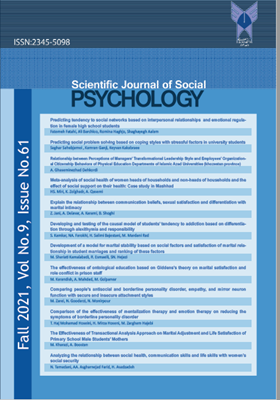Development of a model for predicting the Marital Relations based on Social Factors and Satisfaction of Marital relationship in Student Marriages and ranking of these factors
Subject Areas : social psychology
mohsen shariati kamalabadi
1
,
reza esmaili
2
,
seed naser hejazi
3
![]()
1 - PhD Student in Sociology, Dehaghan Branch, Islamic Azad University, Dehaghan, Iran.
2 - Assistant Professor of Management, Islamic Azad University, Isfahan Branch (Khorasgan), Isfahan, Iran
3 - Assistant Professor, Department of Sociology, Dehaghan Branch, Islamic Azad University, Dehaghan, Iran
Keywords: social factors# marital stability#satisfaction of marital relationship# student marriage,
Abstract :
The purpose of this study was development of a model for predicting the marital stability based on social factors (socio-economic status, social homogeneity, and social capital) and satisfaction of marital relationship in student marriages and ranking of these factors in universities of Isfahan. The research method was descriptive structural equation modeling. The research design was a post-event and structural equation modeling. The statistical population included all of Isfahan universities’ students, including University of Isfahan, Isfahan University of Technology, Khorasgan Azad University and Isfahan University of Medical Sciences, who were married as students between 2016 and 2018. From these individuals, a sample of 687 people was selected by purposive convenience sampling. The assessment tool included a researcher-made questionnaire on Social factors, satisfaction of marital relationship and Marital Stability (Shariati, 2019). Data were analyzed using structural equation modeling and Friedman test. Findings showed that among the social factors, only the factor of social homogeneity of spouses (P <0.05) and satisfaction of marital relationship (P <0.01) are able to significantly explain the marital stability in student marriages. Findings of Friedman test also showed that satisfaction of marital relationship, socio-economic status, social homogeneity and social capital are important in the stability of marriage, respectively and there is a significant difference in the mean rankings (P <0.05). According to these findings, basic programs for marital stability should first focus on education and improving marital relationships, and social factors can be considered in premarital programs.
اعزازی، ش. (1380). خشونت خانوادگی در زنان کتک خورده، تهران: انتشارات عالی.
الوانی، م؛ شیروانی، ع ر. (1383). سرمایه اجتماعی، ماه نامه تدبیر، 147، 22-16.
الوانی، س م؛ سید نقوی، م ع. (1390). سرمایه اجتماعی، مفاهیم و نظریه ها، فصلنامه مطالعات مدیریت، شماره 33و34.
بهاری، س. (1386). بررسی میزان رضایت زناشویی ازدواج های دانشجویی و عوامل موثر در آن، نوآوری های مدیریت آموزشی (اندیشه های تازه در علوم تربیتی)، 2، 4، 40-27.
ریتزر، ج. (1390). نظریه های جامعه شناسی در دوران معاصر، ترجمه محسن ثلاثی، تهران: انتشارات علمی
زارع، ب؛ صفیاری جعفرآباد، ه. (1394). مطالعه رابطه عوامل موثر بر میزان رضایت از زندگی زناشویی در میان زنان و مردان متاهل شهر تهران، فصلنامه مطالعات اجتماعی روان شناختی زنان، 13، 1، 140-111.
ساروخانی، باقر (1393)، جامعه شناسی خانواده، تهران: انتشارات سروش
سازمان ثبت احوال کشور. (1395). دفتر آمار و اطلاعات جمعیتی و مهاجرت.
شریعتی، م. (1398). تبیین عوامل اجتماعی- فرهنگی بر پایداری خانواده در ازدواج های دانشجویی و ارائه مدل مطلوب در دانشگاههای شهر اصفهان، پایان نامه چاپ نشده مقطع دکتری، دانشگاه آزاد اسلامی واحد دهاقان.
صادقی، ر؛ قدسی، ع م ؛ افشار کهن، ج. (1386). واکاوی مساله ازدواج و اعتبارسنجی یک راه حل، زن در توسعه و سیاست (پژوهش زنان)، 5، 1، 17، 108-83.
صیادی، م. (1393). نقش باور به مقدس بودن ازدواج درشادکامی. فصلنامه روان شناسی دین. 7، 1، 25، 58- 47.
کوئن، ب. (1386). درآمدی به جامعه شناسی، ترجمه محسن ثلاثی، تهران: نشر توتیا.
مهدوی، محمدصادق (1377)، بررسی تطبیقی تغییرات ازدواج، تهران: انتشارات دانشگاه شهید بهشتی
نوری، ا. (1389). عوامل تحکیم و استحکام خانواده. طهورا فصلنامه ای در عرصه مطالعات زنان و خانواده، 3، 7، 178-145.
Adler R. B, Towne, N. (1905). Looking out looking in. the ed. Orland: Holt. Rinehart and Winstin Inc. LWZ fee. Assortative mating in man. Science. 22:249 250.
Aspara, J., Wittkowski, K., & Luo, X. (2018). Types of intelligence predict likelihood to get married and stay married: Large-scale empirical evidence for evolutionary theory. Personality and Individual Differences, 122, 1-6.
Carsten, J. (Ed.). (2000). Cultures of relatedness: New approaches to the study of kinship. Cambridge University Press.
Farzanegan, M. R., & Gholipour, H. F. (2016). Divorce and the cost of housing: evidence from Iran. Review of Economics of the Household, 14(4), 1029-1054.
George, D., Luo, S., Webb, J., Pugh, J., Martinez, A., & Foulston, J. (2015). Couple similarity on stimulus characteristics and marital satisfaction. Personality and Individual Differences, 86, 126-131.
Hagedoorn, M., Kuijer, R. G., Buunk, B. P., DeJong, G. M., Wobbes, T., & Sanderman, R. (2000). Marital satisfaction in patients with cancer: Does support from intimate partners benefit those who need it most? Health Psychology, 19(3), 274.
Heller, D., Watson, D., & Ilies, R. (2004). The role of person versus situation in life satisfaction: A critical examination. Psychological bulletin, 130(4), 574.
Lauer, R. H. (1998). Social problems and the quality of life (No. 361.1/L366). McGraw-Hill.
Quek, A. M., Britton, J. W., McKeon, A., So, E., Lennon, V. A., Shin, C., ... & Pittock, S. J. (2012). Autoimmune epilepsy: clinical characteristics and response to immunotherapy. Archives of neurology, 69(5), 582-593.
Stanley, S. M., Rhoades, G. K., & Markman, H. J. (2006). Sliding versus deciding: Inertia and the premarital cohabitation effect. Family relations, 55(4), 499-509.
_||_


